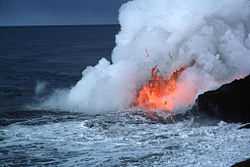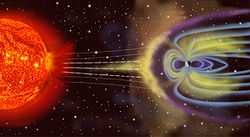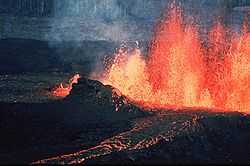Earth science
Earth science is an all-embracing term for the sciences related to the planet Earth.[2] It is arguably a special case in planetary science, the Earth being the only known life-bearing planet. There are both reductionist and holistic approaches to Earth sciences. The formal discipline of Earth sciences may include the study of the atmosphere, hydrosphere, oceans and biosphere, as well as the solid earth. Typically, Earth scientists will use tools from physics, chemistry, biology, chronology and mathematics to build a quantitative understanding of how the Earth system works, and how it evolved to its current state.
Fields of study

The following fields of science are generally categorized within the geosciences:
- Geology describes the rocky parts of the Earth's crust (or lithosphere) and its historic development. Major subdisciplines are mineralogy and petrology, geochemistry, geomorphology, paleontology, stratigraphy, structural geology, engineering geology and sedimentology.[3][4]
- Physical geography covers aspects of geomorphology, soil study, hydrology, meteorology, climatology and biogeography.[5]
- Geophysics and geodesy investigate the shape of the Earth, its reaction to forces and its magnetic and gravity fields. Geophysicists explore the Earth's core and mantle as well as the tectonic and seismic activity of the lithosphere.[4][6][7] Geophysics is commonly used to supplement the work of geologists in developing a comprehensive understanding of crustal geology, particularly in mineral and petroleum exploration. See Geophysical survey.
- Soil science covers the outermost layer of the Earth's crust that is subject to soil formation processes (or pedosphere).[8] Major subdisciplines include edaphology and pedology.[9]
- Oceanography and hydrology (includes limnology) describe the marine and freshwater domains of the watery parts of the Earth (or hydrosphere). Major subdisciplines include hydrogeology and physical, chemical, and biological oceanography.
- Glaciology covers the icy parts of the Earth (or cryosphere).
- Atmospheric sciences cover the gaseous parts of the Earth (or atmosphere) between the surface and the exosphere (about 1000 km). Major subdisciplines are meteorology, climatology, atmospheric chemistry and atmospheric physics.
Earth's interior
Plate tectonics, mountain ranges, volcanoes, and earthquakes are geological phenomena that can be explained in terms of energy transformations in the Earth's crust.[10]
Beneath the Earth's crust lies the mantle which is heated by the radioactive decay of heavy elements. The mantle is not quite solid and consists of magma which is in a state of semi-perpetual convection. This convection process causes the lithospheric plates to move, albeit slowly. The resulting process is known as plate tectonics.[11][12][13][14]
Plate tectonics might be thought of as the process by which the earth is resurfaced. Through a process called seafloor spreading, new crust is created by the flow of magma from underneath the lithosphere to the surface, through fissures, where it cools and solidifies. Through a process called subduction, oceanic crust is pushed underground — beneath the rest of the lithosphere—where it comes into contact with magma and melts—rejoining the mantle from which it originally came.[12][14][15]
Areas of the crust where new crust is created are called divergent boundaries, those where it is brought back into the earth are convergent boundaries and those where plates slide past each other, but no new lithospheric material is created or destroyed, are referred to as transform (or conservative) boundaries[12][14][16] Earthquakes result from the movement of the lithospheric plates, and they often occur near convergent boundaries where parts of the crust are forced into the earth as part of subduction.[17]
Volcanoes result primarily from the melting of subducted crust material. Crust material that is forced into the asthenosphere melts, and some portion of the melted material becomes light enough to rise to the surface—giving birth to volcanoes.[12][17]
Earth's electromagnetic field
An electromagnet is a magnet that is created by a current that flows around a soft iron core.[18] Earth has a solid iron inner core surrounded by semi-liquid materials of the outer core that move in continuous currents around the inner core;[19] therefore, the Earth is an electromagnet. This is referred to as the dynamo theory of Earth's magnetism.[19][20]
Atmosphere

The troposphere, stratosphere, mesosphere, thermosphere, and exosphere are the five layers which make up Earth's atmosphere. In all, the atmosphere is made up of about 78.0% nitrogen, 20.9% oxygen, and 0.92% argon. 75% of the gases in the atmosphere are located within the troposphere, the bottom-most layer. The remaining one percent of the atmosphere (all but the nitrogen, oxygen, and argon) contains small amounts of other gases including CO2 and water vapors.[21] Water vapors and CO2 allow the Earth's atmosphere to catch and hold the Sun's energy through a phenomenon called the greenhouse effect.[22] This allows Earth's surface to be warm enough to have liquid water and support life.
The magnetic field created by the internal motions of the core produces the magnetosphere which protects the Earth's atmosphere from the solar wind.[23] As the earth is 4.5 billion years old,[24] it would have lost its atmosphere by now if there were no protective magnetosphere.
In addition to storing heat, the atmosphere also protects living organisms by shielding the Earth's surface from cosmic rays. Note that the level of protection is high enough to prevent cosmic rays from destroying all life on Earth, yet low enough to aid the mutations that have an important role in pushing forward diversity in the biosphere.
Methodology
Like all other scientists, Earth scientists apply the scientific method. They formulate hypotheses after observing events and gathering data about natural phenomena, and then they test hypotheses from such data.
A contemporary idea within earth science is uniformitarianism. Uniformitarianism says that "ancient geologic features are interpreted by understanding active processes that are readily observed". Simply stated, this means that geological processes occurring today happened in the past -- the present is the key to the past. For example, a mountain need not be thought of as having been created in a moment, but instead it may be seen as the result of continuous subduction, causing magma to rise and form continental volcanic arcs.
Earth's spheres
Earth science generally recognizes four spheres, the lithosphere, the hydrosphere, the atmosphere, and the biosphere;[25] these correspond to rocks, water, air, and life. Some practitioners include, as part of the spheres of the Earth, the cryosphere (corresponding to ice) as a distinct portion of the hydrosphere, as well as the pedosphere (corresponding to soil) as an active and intermixed sphere.
Partial list of the major earth science topics
- See: List of basic earth science topics
Atmosphere
- Atmospheric chemistry
- Climatology
- Meteorology
- Hydrometeorology
- Paleoclimatology
Biosphere
- Biogeography
- Paleontology
- Palynology
- Micropaleontology
- Geomicrobiology
- Geoarchaeology
Hydrosphere
- Hydrology
- Geohydrology
- Limnology (freshwater science)
- Oceanography (marine science)
- Chemical oceanography
- Physical oceanography
- Biological oceanography (marine biology)
- Geological oceanography (marine geology)
- Paleoceanography
Lithosphere or geosphere
|
|
Pedosphere
- Soil science
- Edaphology
- Pedology
Systems
- Environmental science
- Geography
- Human geography
- Physical geography
- Gaia hypothesis
Others
- Cartography
- Geoinformatics (GIS)
- Geostatistics
- Geodesy and Surveying
- NASA Earth Science Enterprise
See also
Template:Portal box Template:Wikipedia books
- Earth sciences graphics software
- Environmental geoscience
- GEO-LEO (GEO Library Experts Online)
- Glossary of geology terms
- List of geoscience organizations
- List of Russian Earth scientists
- Nanogeoscience
- Structure of the Earth
References
- ↑ Encyclopedia of Volcanoes, Academic Press, London, 2000
- ↑ "earth science". Memidex/WordNet Dictionary. Retrieved 2012-06-11.
- ↑ Adams & Lambert 2006, p. 20
- 1 2 Smith & Pun 2006, p. 5
- ↑ Fundamentals of Physical Geography, 2nd Edition, by M. Pidwirny, 2006
- ↑ Wordnet Search: Geodesy
- ↑ NOAA National Ocean Service Education: Geodesy
- ↑ Elissa Levine, 2001, The Pedosphere As A Hub broken link?
- ↑ Duane Gardiner, Lecture: Why Study Soils? excerpted from Miller, R.W. & D.T. Gardiner, 1998. Soils in our Environment, 8th Edition
- ↑ Earth's Energy Budget
- ↑ Simison 2007, paragraph 7
- 1 2 3 4 Adams & Lambert 2006, pp. 94,95,100,102
- ↑ Smith & Pun 2006, pp. 13-17,218,G-6
- 1 2 3 Oldroyd 2006, pp. 101,103,104
- ↑ Smith & Pun 2006, p. 327
- ↑ Smith & Pun 2006, p. 331
- 1 2 Smith & Pun 2006, pp. 325,326,329
- ↑ American Heritage, p. 576
- 1 2 Oldroyd 2006, p. 160
- ↑ Demorest, Paul (2001-05-21). "Dynamo Theory and Earth's Magnetic Field.". Retrieved 2007-11-17.
- ↑ Adams & Lambert 2006, pp. 107-108
- ↑ American Heritage, p. 770
- ↑ Adams & Lambert 2006, pp. 21-22
- ↑ Smith & Pun 2006, p. 183
- ↑ Earth's Spheres. ©1997-2000. Wheeling Jesuit University/NASA Classroom of the Future. Retrieved November 11, 2007.
Further reading
- Allaby M., 2008. Dictionary of Earth Sciences, Oxford University Press, ISBN 978-0-19-921194-4
- Adams, Simon; Lambert, David (2006). Earth Science: An illustrated guide to science. New York, NY: Chelsea House. ISBN 0-8160-6164-5.
- Joseph P. Pickett (executive editor) (1992). American Heritage dictionary of the English language (4th ed.). Boston, MA: Houghton Mifflin Company. ISBN 0-395-82517-2.
- Korvin G., 1998. Fractal Models in the Earth Sciences, Elsvier, ISBN 978-0-444-88907-2
- "Earth's Energy Budget". Oklahoma Climatological Survey. 1996-2004. Retrieved 2007-11-17.
- Miller, George A.; Christiane Fellbaum, and Randee Tengi, and Pamela Wakefield, and Rajesh Poddar, and Helen Langone, and Benjamin Haskell (2006). "WordNet Search 3.0". WordNet a lexical database for the English language. Princeton University/Cognitive Science Laboratory /221 Nassau St./ Princeton, NJ 08542. Retrieved 2007-11-10.
- "NOAA National Ocean Service Education: Geodesy". National Oceanic and Atmospheric Administration. 2005-03-08. Retrieved 2007-11-17.
- Oldroyd, David (2006). Earth Cycles: A historical perspective. Westport, Connicticut: Greenwood Press. ISBN 0-313-33229-0.
- Reed, Christina (2008). Earth Science: Decade by Decade. New York, NY: Facts on File. ISBN 978-0-8160-5533-3.
- Simison, W. Brian (2007-02-05). "The mechanism behind plate tectonics". Retrieved 2007-11-17.
- Smith, Gary A.; Pun, Aurora (2006). How Does the Earth Work?. Upper Saddle River, NJ 07458: Pearson Prentice Hall. ISBN 0-13-034129-0.
- Tarbuck E. J., Lutgens F. K., and Tasa D., 2002. Earth Science, Prentice Hall, ISBN 978-0-13-035390-0
- Yang X. S., 2008. Mathematical Modelling for Earth Sciences, Dunedin Academic Press, ISBN 978-1-903765-92-0
External links
- Earth Science Picture of the Day, a service of Universities Space Research Association, sponsored by NASA Goddard Space Flight Center.
- Geoethics in Planetary and Space Exploration.
- , National Earth Science Teachers Association
- Earth Sciences Degree Program Directory
Template:Physical Earth Template:Earth science Template:Natural sciences-footer Template:Nature nav
